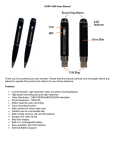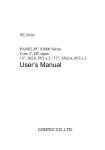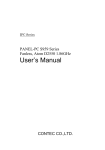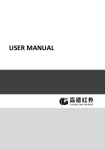Download SDDL (Shaw Super-Dew Deluxe)
Transcript
SUPER-DEW DE-LUXE OPERATING INSTRUCTIONS CONTENTS UNPACKING YOUR SUPER-DEW..................................................................................................... 2 SETTING UP AND INITIAL CALIBRATION.................................................................................... 3 WET LIMIT SETTING (AUTO-CAL) .......................................................................................................... 3 CALIBRATION ROUTINE.................................................................................................................. 4 ALARM SETTINGS.............................................................................................................................. 5 ALARM TRIPS AND HYSTERESIS ............................................................................................................. 5 The Dry Alarm ................................................................................................................................. 5 The Wet Alarm ................................................................................................................................. 5 ANALOGUE OUTPUTS ....................................................................................................................... 5 OPERATION........................................................................................................................................... 6 PROBLEM SOLVING .......................................................................................................................... 7 ANY PROBLEMS?.............................................................................................................................. 7 PROBLEM: Coaxial Short Circuit (external sensor operation)......................................................... 7 PROBLEM: Over Full Scale Reading............................................................................................... 7 PROBLEM: Coaxial Cable Open Circuit ......................................................................................... 7 PROBLEM: Wet Readings - Slow Dry Down .................................................................................... 7 PROBLEM: Short Circuit Sensor (Indication more than full scale) .................................................. 8 Calibration Humidity Jars................................................................................................................ 8 GENERAL INFORMATION................................................................................................................ 9 OPERATING TEMPERATURE .......................................................................................................10 HAZARDOUS AREA INSTALLATION.............................................................................................10 CONSTANT TEMPERATURE UNIT ...............................................................................................10 INSTALLATION CONDITIONS-SENSOR........................................................................................10 PRESSURE .....................................................................................................................................10 VACUUM........................................................................................................................................12 RESPONSE TIME ...........................................................................................................................12 IMPORTANT .....................................................................................................................................13 GUARANTEE ....................................................................................................................................13 SENSOR CABLE ...............................................................................................................................13 BASIC DEFINITIONS .........................................................................................................................14 WATER VAPOUR PRESSURE..........................................................................................................14 RELATIVE HUMIDITY.....................................................................................................................14 DEWPOINT TEMPERATURE...........................................................................................................14 PARTS PER MILLION BY VOLUME ...............................................................................................14 PARTS PER MILLION BY WEIGHT.................................................................................................14 1 Unpacking Your Super-Dew You should have received: (if ordered) 1 Super-Dew De-luxe meter 1 Leather Carrying Case 1 Mains cable 1 Auto-Cal Screwdriver 1 Pressure Calculator If anything is missing please contact your distributor immediately. 2 Setting Up and Initial Calibration Firstly check that the mains rating shown on the back of the Super-Dew meter corresponds with your supply. If this is the case then connect the meter to your supply and switch on. The Super-Dew De-Luxe meter uses a Purple Spot Sensor, and will display dewpoint in deg.C on a bright green backlit liquid crystal display. The Super-Dew De-Luxes Dry setting will have been factory set and should not normally require any further adjustment, however should the need arise then the following procedure must be followed. For De-Luxe models remove the sensor head by unscrewing the three screws securing it to the meter body, lift the head away and disconnect the coaxial cable from the sensor. For Extra versions simply switch the sensor selector switch switch to external. Switch the power on to the meter and the display should read -100 Deg.CDP if this is not the case remove the anti tamper plug if fitted and adjust the control on the front of the meter marked "DRY" with the screwdriver provided until the reading is correct, refit the anti tamper plug if applicable, for De-Luxe models reconnect the sensor, refit the sensor head and perform the Wet Limit Setting (Auto-Cal). For Extra Versions return the sensor selector switch to internal. If using the Super-Dew De-Luxe Extra version with an external sensor then switch the sensor selector switch to external and with no sensor connected adjust the "DRY" potentiometer to display the DRY limit of the sensor you are going to use i.e. -80deg.C DP for a grey spot sensor. Wet Limit Setting (Auto-cal) Switch on the meter and expose the sensor to room air by means of raising and lowering the sensor head 2 or 3 times finishing with the head in the raised position, note the reading on the display, for the purple spot this should be 0 deg.C DP if this is not the case adjust the "WET" potentiometer until the Super-Dew De-Luxe display reads the wet limit of the sensor i.e. 0 deg.C for the purple spot sensor. For Extra versions when using an external sensor and having set the DRY limit as detailed above connect the sensor to the External socket at the rear of the meter and with the sensor exposed to ambient air adjust the "WET" potentiometer to the WET limit or auto-cal setting for the sensor. When returning from external operation to internal please ensure that the DRY limit is reset for the internal sensor and that WET or auto-cal adjustment is performed for the internal sensor also. 3 Calibration Routine Frequency of user calibration can only be determined by initial frequent calibration checks to determine the degree of drift of the wet limit or auto-cal setting. We typically recommend that an auto-cal is performed every three months. and that annually or more frequently if desired the sensor is returned to us or an engineer visits you to perform a multi point calibration check across the range of the sensor and issue a NPL certificate. The dry limit setting should not require any further adjustment after its initial setup unless a different range or external sensor is to be used. 4 Alarm Settings The meter is equipped with two alarm relays which have the provision of normally open and normally closed contacts rated at 240V and 2A. The setpoints of these alarms are adjusted by pressing the relevant button on the front panel of the Super-Dew and whilst holding it down adjust the relevant alarm potentiometer, the set point will be shown on the display of the Super-Dew. Alarm Trips and Hysteresis The Dry Alarm This will trip at the set level as the sensor detects gas passing it which is becoming drier, a degree of hysteresis of approximately 3 deg.C DP is built in to prevent chatter of the relays around the setpoint, this means that the alarm will only reset as the sensor detects the gas passing it becoming wetter by 3 deg.C DP more than the set point. The Wet Alarm This will trip at the set level as the sensor detects gas passing it which is becoming wetter, a degree of hysteresis of approximately 3 deg.C DP is built in to prevent chatter of the relays around the setpoint, this means that the alarm will only reset as the sensor detects the gas passing it becoming wetter by 3 deg.C DP less than the set point. Analogue Outputs The Super-Dew De-Luxe is equipped with an analogue output of 4-20mA The 4-20mA Output This is available at pins 2(+ve) and 3(-ve) at the rear of the Super-Dew on the analogue output port: The setpoints are: 4mA occurs at the dry limit which the meter was initially set to e.g. -100 deg.C DP for a purple spot sensor. 5 20mA occurs at exactly 0 deg.C DP The mA output is linear with dewpoint across this range. It is a current source and must be sunk into a load of no greater than 50 ohms, the internal supply for the mA output is a DC supply of 15 volts. An external supply can be connected observing correct polarity in order to increase the output voltage giving greater flexibility to interface with a range of data capture systems. For Extra versions should an external sensor other than a purple sensor be used then please note that the 4-20 mA output will be affected as follows: 4 mA will always occur at the DRY setting, i.e. -80 for a grey spot sensor. 20 mA will occur exactly 1000 deg.C DP beyond the DRY setting i.e. at + 20deg.C DP for a grey spot sensor which is of course beyond the actual range of the sensor. Operation The Super-Dew De-Luxe should be connected with its head in the lowered position to the gas supply under test using the PTFE tubing supplied to either of the nozzles at the base of the sensor head, the supply to the meter must be regulated to close to atmospheric pressure and to provide a flow rate of 2 to 10 l/min; all though the flow rate is not critical under no circumstances must the flow exceed 20 l/min otherwise serious damage could be caused to the instrument and the surroundings. Allow gas to pass through the device for a sufficient time to purge any atmospheric air from the measuring head (1 minute should suffice), and then close the output nozzle using either a finger or some other means until the pressure in the head causes the head to rise thus exposing the sensor to the gas under test, (should the pressure not be sufficient attach a length of PTFE tubing to the output nozzle and raise the head slowly by hand). Make a note of the reading on the display and when this stabilises take this as your Dewpoint Reading. When you have finished your test remove the gas supply and lower the head by pushing it down thereby enclosing the sensor in desiccant preparing the device for its next use. 6 PROBLEM SOLVING ANY PROBLEMS? 1. SDDL check that the meter indicates dry setting when the coaxial lead is not connected and that the sensor switch is set to external. . 2. SDDL check that the meter reads up to 200 and then 1 - (Overload) when a short circuit is applied to the external coaxial cable with the sensor switch set to external. PROBLEM: Coaxial Short Circuit (external sensor operation) a) b) c) d) Remove sensor and lead from the hygrometer. Note the reading is correct for the dry setting (i.e. with only mains lead connected and with sensor switch set to external i.e. dry dewpoint setting). Refit the coax lead but do not connect the sensor. There should be very little change in reading so it and overload is seen, then fit a new coax lead or repair the same. PROBLEM: Over Full Scale Reading a) b) SDDL hygrometers have a limit reading of 200. If '1' is indicated, turn the Auto Calibration screw anti clockwise with the sensor connected in the room air. PROBLEM: Coaxial Cable Open Circuit a) b) c) d) e) Remove the sensor and apply metal or a wet finger across the sensor end of the cable. No reading indicates an open circuit cable or faulty connection. A scale reading proves that the cable is intact. If the cable is all right, the sensor when connected, should increase the reading. If there is no increase in the reading, check the coax socket on the sensor top or fit a new sensor. PROBLEM: Wet Readings - Slow Dry Down a) b) Place the sensor in the desiccant tin or a dry air supply. Leave overnight to dry out. 7 PROBLEM: Short Circuit Sensor (Indication more than full scale) a) b) c) d) e) Remove the sensor from the coax lead. Note the zero reading without the sensor. Ensure that the auto calibration is not turned up to high. Apply 20/50 volts for a fraction of a second, to the sensor. This will remove the short circuit. If this does not correct the fault, return the sensor under guarantee by post to your supplier. Calibration Humidity Jars a) b) c) d) e) Look inside the jar. Particularly with the Lithium Chloride Jar, check if there is any liquid observed. Wipe out with a tissue. Always replace the stopper quickly. Leave for a day to settle. 8 GENERAL INFORMATION THE SHAW SENSOR. DESCRIPTION, THEORY AND OPERATING CONDITIONS The Shaw high capacitance Sensor has been undergoing continuous development since it was invented by Mr. J L Shaw in the late 1940's. Construction of the Sensor starts with an ultra-high purity aluminum wire which is coated with a hygroscopic layer and finally covered by a film of porous gold. The gold film and the aluminum core form the plates of a capacitor. The capacitance value, and the change in capacitance value over the measuring range of each Sensor (which is at least 100 times greater than in any other Sensor of this type) is measured at supply frequency (50 or 60Hz) which enables long cable lengths (up to 1000M) to be used between each Sensor and the analyzer without any risk of interference or pick-up from external cables or other sources. Some of the water vapour molecules in the atmosphere surrounding the Sensor will enter the dielectric layer where, due to the extremely small size of the pores, their Brownian motion will be restricted and the energy will be removed from the molecules so that they will condense into liquid water. Due to the very high dielectric constant water (about 80) compared with the other vapours which may be present, this produces a marked change in the dielectric value of the Sensor which is then measured by the analyzer. A dynamic equilibrium will exist between the water vapour outside the Sensor and the condensed water within the pores. This equilibrium is maintained, and the response time of the Sensor can generally be considered to be at least as quick as the system into which it is installed. Molecules larger than water vapour (which is one of the smallest gas molecules) cannot enter the pores, making the Sensor resistant to many contaminants and specific to water vapour pressure regardless of the carrier gas. (Molecules of gasses such as Hydrogen will enter the Sensor pores, but their dielectric strength is small enough that no measurable change occurs in the sensor). Temperature: Shaw Sensors are designed to work at normal room temperature. Our long experience of exporting to countries throughout the World has shown that ambient temperature variations can safely be ignored for all practical purposes, so long as the temperature range for each Sensor given below is not exceeded. In particular, avoid placing any Sensor in direct sunlight or near a source or radiant or convected heat. 9 OPERATING TEMPERATURE SENSOR TYPE Red Spot Sensor Grey Spot Sensor Yellow Spot Sensor Gold Spot Sensor Green Spot Sensor MIN. TEMPERATURE -35 deg C -35 deg C -35 deg C +05 deg C +05 deg C MAX. TEMPERATURE +40 deg C +40 deg C +40 deg C +35 deg C +35 deg C HAZARDOUS AREA INSTALLATION The Shaw Sensor has been approved for use as part of an intrinsically safe circuit. This means that it may be installed in an area where there is risk of fire or explosion. The instrument must be located in a safe area, and the length of coaxial cable between the instrument and the Sensor must not be no more than 300 meters. In addition, a Zener Barrier Unit must be installed in the safe area and connection between the instrument and its Sensor. The Zener Barrier Unit is a device which limits the amount of energy which can reach the Sensor, even in a major fault condition, to less than that required to cause a spark which could ignite the explosive gas. CONSTANT TEMPERATURE UNIT This is used in place of the Sensor holder when there is a risk of condensation on the Sensor due to a wide ambient temperature variations or, in non-standard applications, when the gas dewpoint temperature may be higher than the ambient temperature. It should be used in exactly the same way as the Sensor holder, and the thermostat should be set to the temperature on the information supplied with the Sensor. INSTALLATION CONDITIONS-SENSOR PRESSURE The Shaw Sensor is a water vapour pressure detector. This means that it is sensitive to its operating pressure. However, dewpoint temperature is directly proportional to pressure (as the pressure of a gas is increased the dewpoint temperature increases to a wetter level) and so the dewpoint temperature readings given by the instrument remain correct regardless of the pressure at which the Sensor is used. IMPORTANT: it is most important to remember that the parts per million (VPM) scale on the instrument is only correct when the Sensor is operating at 1 bar (A) 10 pressure. If a Sensor is operating at any other pressure the readings in vpm may be corrected by the use of a pressure nomograph or calculator (available from us). 11 Although Shaw Sensors are in regular use at up to 400 bar it is generally preferred that the Sensor be operated at 1 bar (A). The advantages of this are that the readings will not be affected by changes in the gas pressure in the main pipe. However with a typical line pressure of about 7 bars the sensor will never be exposed to free water, even under major fault conditions. As the sample of gas at 1 bar will have a dewpoint temperature of only about 0 deg C. This means that the instrument readings continue to give useful information and recovery of the Sensor after the fault condition has been cured will be very much quicker. The Sensor is a water vapour pressure detector, and free water is an enormous overload. Contamination of the Sensor with free water will, at best make calibration suspect and should be avoided. This is true for all electronic Sensors, regardless of the exaggerated claims made by some of the less scrupulous manufacturers. If readings at line pressure are necessary, we can supply a special scale which will show the line pressure dewpoint temperature with the Sensor operating at 1 bar. The line pressure must be reasonably constant for this to be satisfactory. Alternatively, if the Sensor is operated at line pressure, the standard scale will indicate the correct dewpoint temperature at that pressure directly without correction. VACUUM As stated above the Shaw Sensor is a water vapour pressure detector. It therefore follows that it will operate under vacuum and continue to indicate correctly the water vapour pressure which remains. As with high pressure operation it is important to remember that the vpm scale is only correct with the Sensor operating at 1 bar. The dewpoint temperature readings remain correct regardless of the system pressure or vacuum. Also remember, when changing the pressure in systems containing small amounts of water vapour, that a new equilibrium must be established at a new pressure before the final reading will be obtained. Out-gasing or absorption of the water vapour molecules from the pores of the materials out of which the system is constructed can cause a considerable time delay some times leading to unexpected results. RESPONSE TIME The response time from dry to wet of all Shaw Sensors is a maximum of 30 seconds for 90% of a step change, depending very much upon the moisture level and the temperature. The response from wet to dry depends very much upon the operating conditions, and will be effected by the Sensor, the gas temperature and pressure and the sample flow rate. In general the Sensor is able to establish a new equilibrium water vapour pressure after a change of conditions almost as quickly as the system in which it is installed. In order to obtain the best possible system response time it is important to design the sample system carefully. Use the smallest sample pipe possible (we usually suggest 1/8" o.d.) and use the shortest possible length. It is always preferable to use a longer coax cable to the Sensor, than a long sample pipe from the sample point. The sample flow rate should be adequate for the size of 12 sample system: for an average installation having perhaps 2 metres of 1/8"o.d. pipe before the Sensor, a flow rate of about 1 L/min. is quite sufficient. If a longer sample pipe is used, then the sample flow should be increased. If necessary install a by-pass type system. When the system is installed and a stable reading has been obtained increase the sample flow rate TEMPORARILY, and if a drier reading occurs, it indicates that the original flow rate was too low, or that there is a leak in the system allowing ambient moisture into the sample. IMPORTANT Shaw Sensors are suitable for many different industrial and research applications. Most gases can be checked for their moisture content, and there is no need for the calibration to be altered when changing between different gases - even such different gases as carbon dioxide and hydrogen: the Sensor operates only with reference to the water vapour content. There are some gases which must be avoided as they are not compatible with the materials of construction of the Sensor. Ammonia and Chlorine must be avoided at all times, even in small quantities. HCl also attacks the Sensors very quickly. Gases such as sulphur dioxide (SO2) can be monitored, provided the moisture content is typically < 100 VPM. If in doubt, please check with us first. GUARANTEE All Shaw products are guaranteed for two years from the date of purchase, only excluding accidental damage or misuse. SENSOR CABLE The Sensor cable which is used to connect the Sensor to the instrument must be of the coaxial type and have an impedance of 75ohms and a capacitance of 50pF of less per metre which is available from us in 100, 250 and 500 metre lengths, it is possible to position the Sensor up to 1000 metres away from the instrument. Instruments are despatched with a standard length of 2 metres of cable unless otherwise requested. 13 BASIC DEFINITIONS WATER VAPOUR PRESSURE Is the pressure exerted by the water vapour contained in any mixture of gases. The total pressure exerted by the gas mixture is the sum of the pressures exerted by its components - including the water vapour. Water vapour pressure varies in direct proportion to the total gas pressure. RELATIVE HUMIDITY Is the ratio of the actual water vapour pressure to the saturation water vapour pressure at the same temperature. DEWPOINT TEMPERATURE Is defined as the temperature to which the gas must be cooled in order that it should be saturated with water vapour (i.e.100% relative humidity). For practical reasons it is referred to water above 0 deg C and ice below 0 deg C. PARTS PER MILLION BY VOLUME PPM(V) or VPM is the ratio of the water vapour pressure to the total gas pressure. PARTS PER MILLION BY WEIGHT PPM(W) is the same as VPM, except that the figure is modified according to the ratio of the molecular weight of water vapour to the molecular weight of the carrier gas mixture. 14























